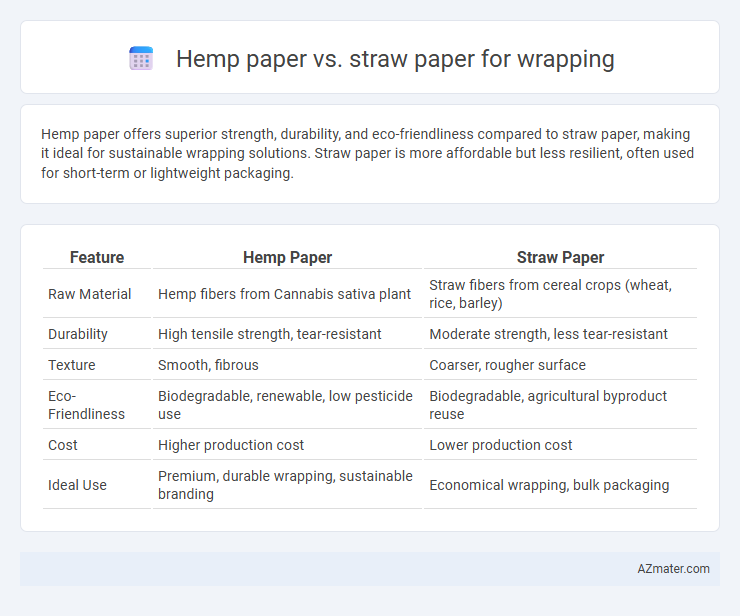Hemp paper offers superior strength, durability, and eco-friendliness compared to straw paper, making it ideal for sustainable wrapping solutions. Straw paper is more affordable but less resilient, often used for short-term or lightweight packaging.
Table of Comparison
| Feature | Hemp Paper | Straw Paper |
|---|---|---|
| Raw Material | Hemp fibers from Cannabis sativa plant | Straw fibers from cereal crops (wheat, rice, barley) |
| Durability | High tensile strength, tear-resistant | Moderate strength, less tear-resistant |
| Texture | Smooth, fibrous | Coarser, rougher surface |
| Eco-Friendliness | Biodegradable, renewable, low pesticide use | Biodegradable, agricultural byproduct reuse |
| Cost | Higher production cost | Lower production cost |
| Ideal Use | Premium, durable wrapping, sustainable branding | Economical wrapping, bulk packaging |
Introduction to Plant-Based Wrapping Papers
Plant-based wrapping papers, such as hemp paper and straw paper, offer sustainable alternatives to traditional plastic and wood pulp options by utilizing renewable agricultural resources. Hemp paper is renowned for its durability, resistance to tearing, and biodegradability, making it ideal for eco-friendly packaging. Straw paper, derived from cereal crop residues, provides a lightweight, cost-effective, and compostable wrapping solution that reduces waste by repurposing agricultural byproducts.
Overview of Hemp Paper
Hemp paper, made from the fibers of the Cannabis sativa plant, offers superior durability and sustainability compared to straw paper due to its longer fibers and faster growth cycle. Its high tensile strength and resistance to tearing make hemp paper an ideal choice for eco-friendly and recyclable wrapping solutions. The naturally resistance to mold and UV degradation enhances the longevity of hemp paper, positioning it as a premium material in sustainable packaging markets.
Overview of Straw Paper
Straw paper, produced from agricultural residues like wheat and rice straw, offers an eco-friendly alternative to traditional wood pulp paper by utilizing waste materials that would otherwise be discarded. Its fibrous composition provides reasonable durability and flexibility, making it suitable for various wrapping applications where sustainability is a priority. Compared to hemp paper, straw paper generally has a lighter texture and lower tensile strength but stands out for its cost-effectiveness and abundant raw material supply.
Raw Material Sourcing and Availability
Hemp paper for wrapping is derived from the bast fibers of the hemp plant, known for its rapid growth and sustainable cultivation, making raw material sourcing highly renewable and eco-friendly. Straw paper sourcing relies on agricultural byproducts from cereal crops, such as wheat or rice straw, offering ample availability but often fluctuating with seasonal harvests and regional crop production. Hemp's consistent and scalable supply chain provides a more reliable raw material foundation compared to straw, whose availability may be limited by competing uses and geographic constraints.
Environmental Impact Comparison
Hemp paper significantly outperforms straw paper in environmental impact due to its faster growth rate and lower pesticide use, requiring only about 4 months to mature compared to straw's seasonal cycle. Hemp cultivation improves soil health through phytoremediation, reduces carbon emissions by absorbing up to 15 tons of CO2 per hectare annually, and supports sustainable farming practices. Conversely, straw paper production often relies on agricultural byproducts with limited carbon sequestration benefits and may involve more energy-intensive processing, making hemp paper a more eco-friendly choice for wrapping materials.
Production Processes: Hemp vs Straw Paper
Hemp paper production involves processing hemp fibers through mechanical and chemical pulping methods, which yield strong, durable fibers ideal for wrapping materials. Straw paper manufacturing uses agricultural residues like wheat or rice straw, requiring extensive pulping and bleaching to remove lignin and other impurities, resulting in a softer, less resilient paper. Both processes emphasize sustainability, but hemp's higher fiber strength often leads to a more eco-friendly and long-lasting wrapping solution compared to straw paper.
Strength and Durability Analysis
Hemp paper demonstrates superior strength and durability compared to straw paper due to its long, robust fibers that provide enhanced tear resistance and tensile strength. Its natural lignin content and fiber structure contribute to better moisture resistance and longevity under stress, making it ideal for heavy-duty wrapping applications. In contrast, straw paper, made from shorter and more brittle fibers, tends to be less durable and more prone to tearing, reducing its effectiveness for prolonged or rigorous use.
Wrapping Performance and User Experience
Hemp paper offers superior durability and tear resistance compared to straw paper, making it ideal for wrapping heavier or irregularly shaped items without compromising the package's integrity. Its natural fibers provide a smoother surface, enhancing print quality and overall user experience during handling and unwrapping. Straw paper, while eco-friendly and cost-effective, tends to be more brittle and less flexible, which may lead to easier tearing and reduced protection during transport.
Cost and Market Accessibility
Hemp paper generally incurs higher production costs compared to straw paper due to the intensive processing required for hemp fibers, impacting its market price. Straw paper benefits from abundant raw materials and lower manufacturing expenses, making it more accessible and affordable for mass-market wrapping solutions. Market accessibility favors straw paper as it is widely available in regions with significant agricultural byproduct utilization, whereas hemp paper is limited by regulatory constraints and less established supply chains.
Future Trends in Sustainable Wrapping Papers
Hemp paper offers exceptional durability and biodegradability, making it a promising candidate for sustainable wrapping solutions as the demand for eco-friendly packaging grows. Straw paper, derived from agricultural residues, provides a resource-efficient alternative with lower environmental impact and cost-effectiveness, aligning with circular economy principles. Advancements in processing technologies and growing regulatory support are likely to accelerate the adoption of both hemp and straw papers in future sustainable wrapping markets.

Infographic: Hemp paper vs Straw paper for Wrapping
 azmater.com
azmater.com